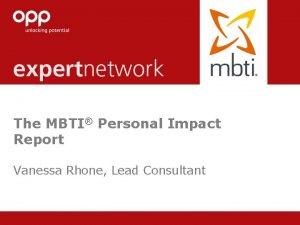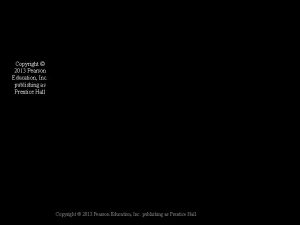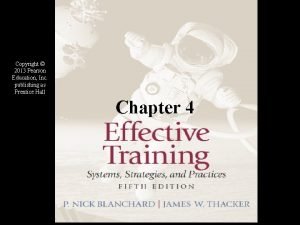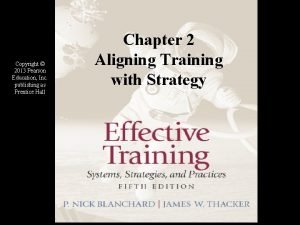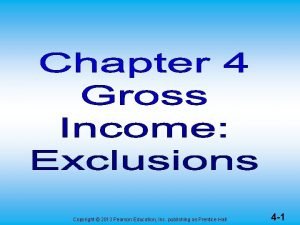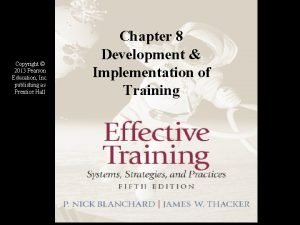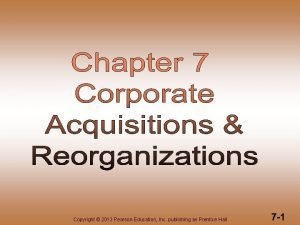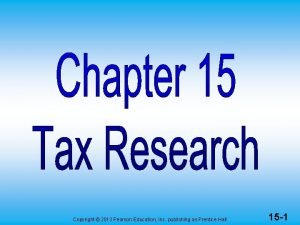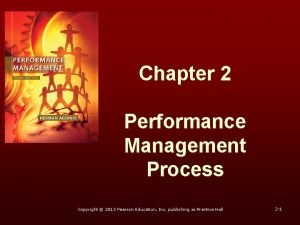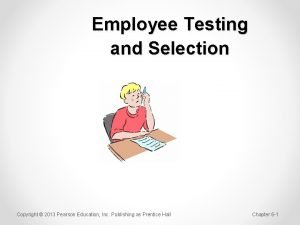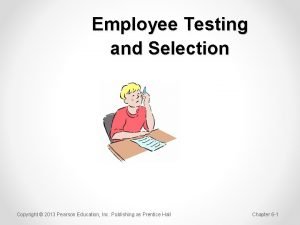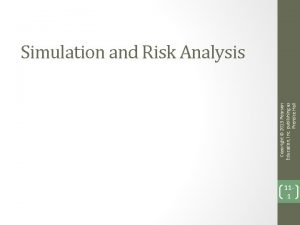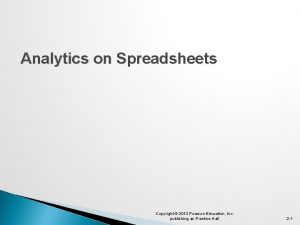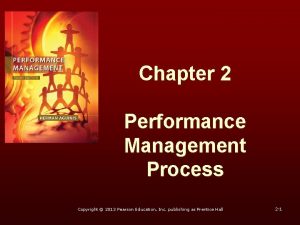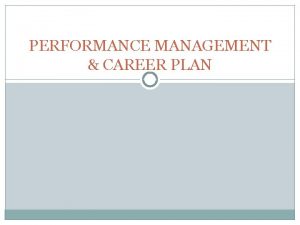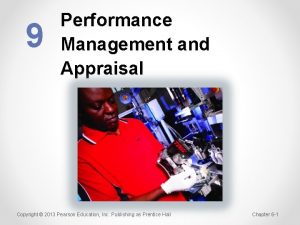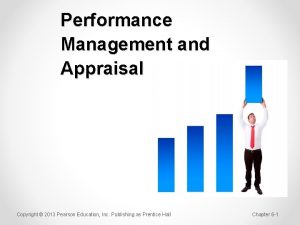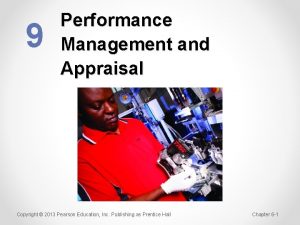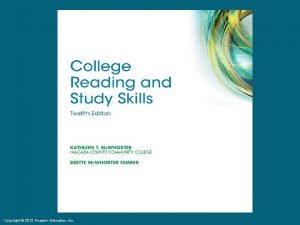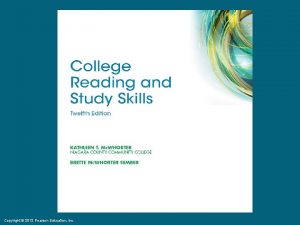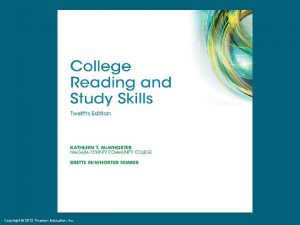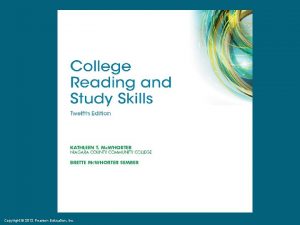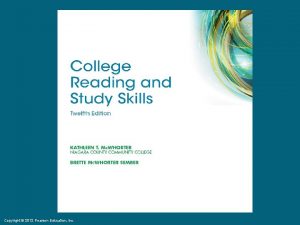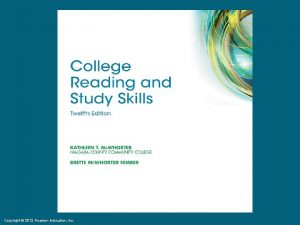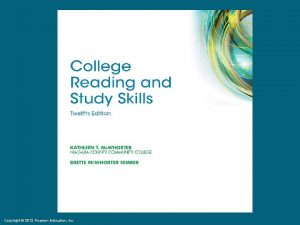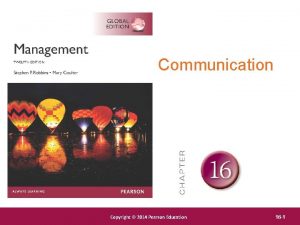Chapter 9 Performance Management Skills Copyright 2013 Pearson








































- Slides: 40

Chapter 9 Performance Management Skills Copyright © 2013 Pearson Education, Inc. publishing as Prentice Hall 9 -1

Coaching: Definition n Coaching involves establishing a helping and trusting relationship between the manager and each of his/her subordinates in which s/he directs, motivates, and rewards employee behavior. Coaching is a day-to-day function that involves observing performance, complimenting good work, and helping to correct and improve any performance that does not meet standards. Coaching is concerned with long-term performance and involves ensuring that the developmental plan is being achieved. Copyright © 2013 Pearson Education, Inc. publishing as Prentice Hall 9 -2

Guiding Principles for Successful Coaching n n n A good coaching relationship is essential – The relationship must be trusting and collaborative and the manager must coach with empathy and compassion. To achieve this relationship the coach must listen in order to understand the employee and must look for positive aspects of the employee because this is likely to lead to a better understanding and acceptance of the employee. The coach must understand that coaching is done with the employee, not to the employee. Copyright © 2013 Pearson Education, Inc. publishing as Prentice Hall 9 -3

Guiding Principles for Successful Coaching n n n The employee is the source and director of change – The coach must understand that the employee is the source of change and self-growth. Accordingly, the coach needs to facilitate the employee’s setting the agenda, goals, and direction. The employee is a whole and unique individual with job-related and job-unrelated identities – With this knowledge the coach can help the employee connect his life and work experiences in meaning ways. The coach is the facilitator of the employee’s growth – The coach must facilitate but not take control of the process. Copyright © 2013 Pearson Education, Inc. publishing as Prentice Hall 9 -4

Major Coaching Functions n n n Giving advice to help employees improve their performance. Providing guidance so employees can develop their skills and knowledge appropriately. Providing employees with support and being there only when the manager is needed. Giving employees confidence that will enable them to enhance their performance continuously and to increase their sense of responsibility for managing their own performance. Helping employees gain greater competence by guiding them toward acquiring more knowledge and skills. Copyright © 2013 Pearson Education, Inc. publishing as Prentice Hall 9 -5

Key Coaching Behaviors n n n n Work with employees to establish developmental plans and objectives. Communicate clearly and effectively with employees about their performance, including behaviors and results. Motivate employees by rewarding their positive performance. Document instances of good and poor performance. Give feedback. Diagnose performance problems – Managers must gather information to determine whether performance deficiencies are due to lack of KSAs, motivation, or situational factors beyond the employee’s control. Provide resources and financial support to develop employees. Copyright © 2013 Pearson Education, Inc. publishing as Prentice Hall 9 -6

Coaching Styles n n Driver – Coach tells the employee being coached what to do. Persuader – Coach tries to sell what s/he wants the employee to do. Amiable – Coach wants the employee to be happy and is not very assertive. Analyzer – Coach asks the employee to follow the rules and procedures when providing a recommendation. Copyright © 2013 Pearson Education, Inc. publishing as Prentice Hall 9 -7

Which Coaching Style is Best? No one style of coaching is best. Rather, being adaptive and using various styles is the best approach. In other words, good coaches: n sometimes provide direction. n sometimes persuade. n sometimes show empathy. n sometimes closely follow the rules and procedures when providing a recommendation to employees. Copyright © 2013 Pearson Education, Inc. publishing as Prentice Hall 9 -8

Coaching Process Set Developmen tal Goals Identify Development al Resources & Strategies Implement Strategies Give Feedback Observe and Document Development al Behavior Copyright © 2013 Pearson Education, Inc. publishing as Prentice Hall 9 -9

Coaching Process n n n Set developmental goals – These goals must be reasonable, attainable, derived from an analysis of an employee’s needs to improve, and take into account both short- and longterm career objectives. Identify resources and strategies (e. g. , OJT, attending courses, mentoring) that will help the employee achieve the developmental goals. Implement strategies that will allow the employee to achieve the developmental goals. Copyright © 2013 Pearson Education, Inc. publishing as Prentice Hall 9 -10

Coaching Process (continued) n n Observe and document developmental behavior – Collect and evaluate data to assess the extent to which each of the developmental goals has been achieved. Give feedback – The coach provides feedback to the employee, and, based on the extent to which each of the goals has been achieved, the developmental goals are revised, and the entire process begins again. Copyright © 2013 Pearson Education, Inc. publishing as Prentice Hall 9 -11

Observing and Documenting Developmental Behavior Constraints managers may experience: n Time – Managers may be too busy to observe and document an employee’s behaviors. n Situation – Managers may be unable to observe employees as they engage in developmental activities (e. g. , an employee enrolled in an online course). n Activity – When the developmental activity is highly unstructured (e. g. , an employee reading a book) the manager may have to wait until the activity is completed to access whether it has been beneficial. Copyright © 2013 Pearson Education, Inc. publishing as Prentice Hall 9 -12

Addressing the Constraints of Observing and Documenting Developmental Behavior n n A good communication plan should explain the benefits of implementing a developmental plan effectively. This helps managers accept the plan. Managers should be trained so that they minimize rater errors, observe behavior properly, understand what it means to complete developmental activities successfully, and are comfortable and confident in managing employees’ developmental activities. Copyright © 2013 Pearson Education, Inc. publishing as Prentice Hall 9 -13

Reasons to Document Developmental Behavior n n Minimizes cognitive load – Documentation helps prevent memory related errors. Creates trust – Documentation creates a record of behaviors which, in turn, promotes trust. Plan for the future – Documenting developmental activities and their outcomes enables discussion about specific facts and thus permits better planning of developmental activities for the future. Provides legal protection against litigation based on discrimination. Copyright © 2013 Pearson Education, Inc. publishing as Prentice Hall 9 -14

What Managers Can Do to Document Performance and Developmental Activities Be specific – Document events and outcomes. Avoid making general statements. n Use adjectives and adverbs sparingly – The use of adjectives (e. g. , good, poor) and adverbs (e. g. , sometimes) may lead to ambiguous interpretations. n Balance positives with negatives – Document instances of both good and poor performance. n Focus on job-related information n Be comprehensive n Standardize procedures – Use the same method to document for all employees. n Describe observable behavior – Phrase your notes in behavioral terms and avoid statements that are subjective judgments. n Copyright © 2013 Pearson Education, Inc. publishing as Prentice Hall 9 -15

Giving Feedback includes information about both positive and negative aspects of job performance and lets employees know how well they are doing in meeting the established standards. Feedback has several purposes: 1. Helps build confidence – Praising good performance builds employee confidence. 2. Develops competence – Feedback about how to improve performance develops employee competence and improves future performance. 3. Enhances involvement – Receiving feedback and discussing performance allows employees to better understand their roles in their unit. Copyright © 2013 Pearson Education, Inc. publishing as Prentice Hall 9 -16

Possible Costs of Not Providing Feedback n n n Employees would be deprived of a chance to improve their performance. Organization would experience chronic poor performance because employees would not recognize their performance problems and would continue to perform at substandard levels. Employees might develop inaccurate perceptions of how their performance is regarded by others. Copyright © 2013 Pearson Education, Inc. publishing as Prentice Hall 9 -17

How to Enhance Feedback n n n n Timeliness – Give feedback close to the time of the performance event. Frequency – Give feedback on an ongoing basis. Specificity – Give feedback about specific work behaviors and results. Verifiability –Feedback should include information that is verifiable. Be consistent (over time and across employees) Privacy – Feedback should be given privately to each employee. Consequences – Feedback should explain the consequences of the employee’s behavior for the organization, customers, other employees, etc. Copyright © 2013 Pearson Education, Inc. publishing as Prentice Hall 9 -18

How to Enhance Feedback (Continued) n n n Description first, evaluation second – Feedback should first focus on describing behaviors and results rather than on evaluating them. Performance continuum – Feedback should include information on how to display good performance behaviors more often and poor performance behaviors less often. Pattern Identification – ID a pattern of poor performance rather than isolated incidents. Demonstrate confidence in employee Advice and idea generation – Feedback should include advice given by the supervisor and ideas from the employee about how to improve performance Copyright © 2013 Pearson Education, Inc. publishing as Prentice Hall 9 -19

Guidelines for Giving Praise n n Praise should be sincere and only given when it is deserved. Praise should be given about specific behaviors or results so employees know what they should repeat in the future. In giving praise, managers should take their time and act pleased rather than rushing through the information and looking embarrassed. Avoid giving praise by referring to the absence of the negative (e. g. , “not bad”). Rather, praise should emphasize the positive. Copyright © 2013 Pearson Education, Inc. publishing as Prentice Hall 9 -20

Giving Negative Feedback Managers may avoid giving negative feedback because: n negative reactions and consequences may occur. n they themselves may have received negative feedback and felt hurt or upset. Managers may not want to put their subordinates in such a situation. n they are reluctant to play the role of an allknowing, judgmental “God”. n it is hard for them to gather irrefutable and conclusive evidence about a performance problem. Copyright © 2013 Pearson Education, Inc. publishing as Prentice Hall 9 -21

Negative Feedback Is Most Useful When It n n n identifies warning signs and performance problems that are still manageable. clarifies unwanted behaviors and consequences. focuses on behaviors that can be changed. comes from a credible source. is supported by hard data. Copyright © 2013 Pearson Education, Inc. publishing as Prentice Hall 9 -22

Feedback Sessions Should Always Answer the Following Questions n n How is your job going? Do you have what you need to do your job (e. g. , proper equipment)? Are you adequately trained? Do you have the skills and tools you need to do your job? Copyright © 2013 Pearson Education, Inc. publishing as Prentice Hall 9 -23

Feedback Sessions Should Always Answer the Following Questions (continued) n n What can be done to improve your job and the products produced or the services provided by your unit? How can you better serve your internal and external customers? Copyright © 2013 Pearson Education, Inc. publishing as Prentice Hall 9 -24

Disciplinary Process and Termination n Formal disciplinary process involves • Verbal warning • Written warning. . . which may lead to termination Copyright © 2013 Pearson Education, Inc. publishing as Prentice Hall 9 -25

Disciplinary Process and Termination n Optional step prior to formal disciplinary process: • Decision-making leave A decision-making leave is a “day of contemplation” that is paid and allows the employee to stay home and decide whether working in this organization is what he or she really wants to do. Copyright © 2013 Pearson Education, Inc. publishing as Prentice Hall 9 -26

Disciplinary Process and Termination n Five pitfalls to be avoided in the termination of an employee Copyright © 2013 Pearson Education, Inc. publishing as Prentice Hall 9 -27

Disciplinary Process and Termination n n Pitfall #1: Acceptance of poor performance Suggestion: Do not ignore the problem, address it immediately Copyright © 2013 Pearson Education, Inc. publishing as Prentice Hall 9 -28

Disciplinary Process and Termination n n Pitfall #2: Failure to get the message through Suggestion: Be specific about the performance problem and the consequences of not addressing it effectively Copyright © 2013 Pearson Education, Inc. publishing as Prentice Hall 9 -29

Disciplinary Process and Termination n n Pitfall #3: Performance standards are “unrealistic” or “unfair” Suggestion: Remind employees of the fairness of the performance standard and provide documentation of the poor performance Copyright © 2013 Pearson Education, Inc. publishing as Prentice Hall 9 -30

Disciplinary Process and Termination n n Pitfall #4: Negative affective reactions Suggestion: Do not let emotional reactions derail you from your missions of describing the nature of the problem, what needs to be done, and the consequences of not doing so Copyright © 2013 Pearson Education, Inc. publishing as Prentice Hall 9 -31

Disciplinary Process and Termination n n Pitfall #5: Failure to consult Human Resources Suggestion: Consult with Human Resources regarding legal requirement prior to termination Copyright © 2013 Pearson Education, Inc. publishing as Prentice Hall 9 -32

Disciplinary Process and Termination n Suggestions for the termination meeting: • Be respectful • Get right to the point • Wish the employee well • Send the employee to HR • Have the employee leave immediately • Have the termination meeting at the end of the day Copyright © 2013 Pearson Education, Inc. publishing as Prentice Hall 9 -33

Supervisory Roles in Managing Performance n Judge • Evaluate performance • Allocate rewards n Coach • Help employee solve performance problems • Identify performance weaknesses • Design developmental plans Copyright © 2013 Pearson Education, Inc. publishing as Prentice Hall 9 -34

Performance Review Formal Meetings Possible types of formal meetings: 1. 2. 3. 4. 5. 6. System Inauguration Self-Appraisal Classical Performance Review Merit/Salary Review Developmental Plan Objective Setting Copyright © 2013 Pearson Education, Inc. publishing as Prentice Hall 9 -35

Steps to Take Before Meeting n n n Give at least two weeks notice Block sufficient time Arrange to meet in a private location without interruptions Copyright © 2013 Pearson Education, Inc. publishing as Prentice Hall 9 -36

Merged Performance Review Meeting Components 1. 2. 3. 4. 5. 6. 7. 8. 9. Explanation of meeting purpose Employee self-appraisal Supervisor and employee share rating and rationale Developmental discussion Employee summary Rewards discussion Follow-up meeting arrangement Approval and appeals process discussion Final recap Copyright © 2013 Pearson Education, Inc. publishing as Prentice Hall 9 -37

Possible Defensive Behaviors of Employees n Fight response • • n Blaming others Staring at supervisor Raising voice Other aggressive responses Flight response • • • Looking/turning away Speaking softly Continually changing the subject Quickly agreeing without basis Other passive responses Copyright © 2013 Pearson Education, Inc. publishing as Prentice Hall 9 -38

To Prevent/Reduce Defensive Behaviors n n n Establish and maintain rapport Be empathetic Observe verbal and nonverbal cues Minimize threats Encourage participation Copyright © 2013 Pearson Education, Inc. publishing as Prentice Hall 9 -39

When Defensiveness Is Unavoidable Ø Ø Recognize it Allow its expression Ø Accept employee’s feelings Ø Ask for additional information and clarification (if appropriate) If situation becomes intolerable: Ø Reschedule the meeting for a later time Copyright © 2013 Pearson Education, Inc. publishing as Prentice Hall 9 -40
 Mbti personal impact report
Mbti personal impact report 2013 pearson education inc
2013 pearson education inc 2013 pearson education inc
2013 pearson education inc 2013 pearson education inc
2013 pearson education inc 2013 pearson education inc
2013 pearson education inc 2013 pearson education inc
2013 pearson education inc 2013 pearson education inc
2013 pearson education inc 2013 pearson education inc
2013 pearson education inc 2013 pearson education inc
2013 pearson education inc 2013 pearson education inc
2013 pearson education inc Are clusters of measurable ksas
Are clusters of measurable ksas 2013 pearson education inc. answers
2013 pearson education inc. answers 2013 pearson education inc. answers
2013 pearson education inc. answers 2013 pearson education inc
2013 pearson education inc 2013 pearson education inc
2013 pearson education inc 2017 pearson education ltd
2017 pearson education ltd 2017 pearson education inc
2017 pearson education inc 2010 pearson education inc
2010 pearson education inc Copyright 2009
Copyright 2009 Copyright pearson education inc
Copyright pearson education inc Copyright 2014 pearson education inc
Copyright 2014 pearson education inc Copyright 2010 pearson education inc
Copyright 2010 pearson education inc Copyright 2010 pearson education inc
Copyright 2010 pearson education inc Copyright by pearson education inc. answers
Copyright by pearson education inc. answers Copyright 2003 pearson education inc
Copyright 2003 pearson education inc Copyright 2005 pearson prentice hall inc
Copyright 2005 pearson prentice hall inc Copyright 2009 pearson education inc
Copyright 2009 pearson education inc Copyright pearson education inc
Copyright pearson education inc Copyright 2010 pearson education inc
Copyright 2010 pearson education inc Copyright 2010 pearson education inc
Copyright 2010 pearson education inc Copyright 2010 pearson education inc
Copyright 2010 pearson education inc Copyright 2010 pearson education inc
Copyright 2010 pearson education inc Copyright 2010 pearson education inc
Copyright 2010 pearson education inc Composition copyright example
Composition copyright example Pearson education inc all rights reserved
Pearson education inc all rights reserved Copyright 2009 pearson education inc
Copyright 2009 pearson education inc Copyright 2009 pearson education inc
Copyright 2009 pearson education inc Copyright 2009 pearson education inc
Copyright 2009 pearson education inc Copyright 2009 pearson education inc
Copyright 2009 pearson education inc Copyright pearson education inc
Copyright pearson education inc Chapter 11 performance appraisal - (pdf)
Chapter 11 performance appraisal - (pdf)
